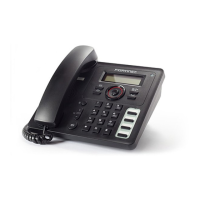Installation Page 5 FortiFone™ User Guide for FON-260i
Provisioning the Phone
For instructions on programming your FortiVoice phone system for the phone, please refer to
“Adding IP Phones” in Chapter 2 of the FortiVoice User Guide.
For internal use
The phone supports ‘plug and play’ installation employing the automated provisioning process
for discovering FortiVoice phone systems.
After discovering the FortiVoice system on the LAN, the phone downloads the configuration and
registers with FortiVoice. If the extension was pre-configured via the FortiVoice management
software, then the phone display should show the extension number and name. If not yet
configured in the FortiVoice system, then the MAC address of the phone will be visible as a
choice in the MAC select list for that model of phone in the “Local Extensions” section of the
configuration.
For external use
When connecting your IP phone at a remote location for external use, perform the following
steps:
1. Preconfigure the extension in the FortiVoice management software.
2. Power up the phone and press the button, then select 3. Phone Settings.
3. Select 6. Firmware Update and press the OK button.
4. From the Firmware Update menu, select 2. TFTP Server Address.
5. Enter the Public IP address or FQDN of your FortiVoice system. Press the OK button.
6. Press the button to exit the configuration then press the OK button to reboot the
phone.
If the phone still says “Not Registered” after 30 seconds, see “Troubleshooting” on page 59.
If you encounter problems, ensure the appropriate ports are forwarded from the firewall to the
FortiVoice system. For more information, see the FortiVoice User Guide.

